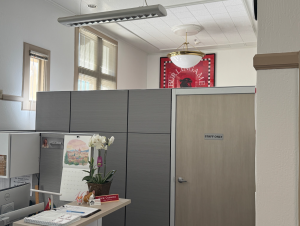Shoplifting culture: the disturbing rate of stealing among teenagers

Students at Burlingame acknowledged that they have shoplifted in the past, reflecting national trends.
February 17, 2023
In “Ginny & Georgia,” 15-year-old Ginny and her gaggle of friends swipe a shirt and jewelry from the mall. Although the store owner spots them, the girls escape any real consequences.
Much like Ginny, teenagers are all too familiar with slipping an item in their purses — and getting away with it. According to Deep Sentinel, approximately 10-11% of the U.S. population has shoplifted at some point in their lives, and shoplifting is most prominent among teenagers. Whether the stolen valuables are food, alcohol, clothes or, at Burlingame, other students’ Physical Education (PE) locker locks, shoplifting among teenagers is no longer a rare occurrence.
In recent years, popular teenage retail brands such as Brandy Melville, Pacsun, and Urban Outfitters have lost mass profits due to customers shoplifting. According to the Los Angeles Times, for every $1 billion in sales that a retail store makes, $700,000 is lost to theft. California only covers 10% of the price of a retail store’s stolen items, so businesses lose 1-5% of a store’s annual stock, according to the U.S. Department of Justice.
“Many contribute [to stealing] because it could be a way to ‘seem cool’ or impress others. But at the same time, many people are just reluctant to spend over a certain budget for clothing, accessories, or whatever it may be,” sophomore Sophia Geminder said. “Take stores like Urban Outfitters, for example. Some basic shirts cost almost $70, and not a lot of people are willing to spend that type of money on something they won’t wear every day.”
While Geminder believes that shoplifting is attractive because of soaring clothing costs, she also thinks that an element of its appeal is the “simplicity” of the crime.
“That’s the accessibility of shoplifting, especially in stores where there are no security tags or buzzers to catch you,” Geminder said. “I think people also tend to forget about the serious consequences associated with shoplifting because they don’t think they will get caught, which is why it has become so normalized.”
Arrests and charges for retail theft have dropped 70% between 2017 and 2021, while reported incidents rose 21%, according to The Philadelphia Inquirer.
An anonymous source — who attends Burlingame — disclosed that shoplifting is addictive and that shoplifters like him are unable to quit because of the serotonin it gives them. The source, who has stolen roughly $5,000 worth of items from retail stores such as Lululemon and The North Face, admitted that acquiring new items makes him feel both happy and accomplished. However, he also claimed that if he had a higher allowance from his parents, he would pay for the items instead.
Another anonymous source said they were similarly reliant on shoplifting.
“To be honest, I steal everything. Half of my closet is stolen. I haven’t paid for clothes in the past two months,” the source said. “Why would you pay for something when someone you know is stealing it and paying nothing for it?”
According to Impact Law, theft is the most common crime among teenagers in America. The crime is so prevalent that students are even stealing unattended belongings from the PE locker rooms. PE teacher Anthony Dimech believes the issue originates with lost or misplaced locks.
“We probably have about 75 locks that are lost because [students] misplace them. They don’t close their lockers. Every day when I walk around, I’m closing someone’s lock, or I’m picking up a lock off the floor,” Dimech said.
Moreover, Dimech gives a locker room talk to his students every day, reminding them that items don’t get stolen unless they’re left in the open or other classmates know the combination.
“If you can pick a lock in front of me, I’ll give you $100. No one’s ever been able to do so,” Dimech said.
Because many people forget to lock their lockers and keep expensive valuables at school, students often lose costly clothing and accessories during Flex Time periods, when students steal the most.
Another anonymous source revealed that during Flex Time, groups of girls will sometimes take items in the locker room if they see the item has been there for a few days. For example, if a pair of jeans has been unclaimed after a week, some individuals will take the jeans for themselves. Although the girls won’t reach into unlocked lockers or unzipped backpacks, items that are “laid out in the open” are what catches their eye.
“Shoplifting is so normalized in our society that it creates an environment where you feel left out if you don’t [partake in stealing],” junior Tem Battsooj said.






































